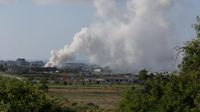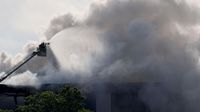Spanish authorities issued a stay-at-home order for over 160,000 residents in the coastal region of Catalonia after a fire at an industrial warehouse released a toxic cloud of chlorine. The incident occurred early on Saturday, May 10, 2025, in Vilanova i la Geltru, just south of Barcelona. Firefighters reported that the fire originated in a building used for storing swimming pool cleaning products.
The Civil Protection Service of Catalonia took to social media to alert citizens, stating, "If you are in the affected area, do not leave your home or workplace." The at-risk area spanned five municipalities, stretching from Vilanova i la Geltru to the village of Calafell, near Tarragona. Fortunately, no casualties were reported.
As the fire raged, it generated a significant cloud of chlorine gas, prompting the authorities to close roads and train stations to prevent further movement into the area. Firefighters worked diligently to extinguish the flames while monitoring the toxic gas cloud for any changes in its toxicity levels. The mayor of Vilanova, Juan Luis Ruiz López, explained that the water used by firefighters reacted chemically with the chlorine, exacerbating the situation.
By midday, the head of the Interior of Catalonia, Núria Parlon, announced the lifting of the confinement order. "The confinement is lifted," she stated during a press conference shortly after 12:15 PM local time. However, she advised vulnerable individuals, children, and those engaging in sports to remain indoors as a precautionary measure.
Despite the lifting of the order, local firefighters urged residents to remain vigilant. They noted that depending on wind conditions and the movement of the toxic cloud, further localized confinements could be necessary. "Chlorine rarely ignites, but when it burns, it is very difficult to extinguish," said Jorge Viñuales Alonso, the owner of the industrial property, in an interview with local radio.
The incident has raised questions about safety protocols in industrial storage facilities, particularly those handling hazardous materials. As the investigation into the fire's cause continues, initial reports suggest that a lithium battery may have been responsible. This revelation has sparked discussions among local officials about the need for stricter regulations and safety measures to prevent similar incidents in the future.
Residents of the affected areas expressed relief at the lifting of the confinement but remained cautious about potential health risks from lingering toxins. Many questioned whether enough was being done to ensure their safety and prevent future occurrences. Local health officials have been dispatched to monitor air quality in the region and provide guidance on any necessary health precautions.
The events of May 10, 2025, serve as a stark reminder of the dangers posed by industrial accidents and the importance of swift and effective emergency response. As communities recover from the incident, the focus will likely shift to enhancing safety measures and ensuring that residents feel secure in their homes.
In the wake of the fire, local authorities are also considering public education campaigns to raise awareness about the risks associated with hazardous materials and the importance of following emergency protocols. This incident highlights the critical need for both community preparedness and robust regulatory frameworks to mitigate the risks posed by industrial activities.
As investigations continue, the community of Vilanova i la Geltru stands united in its resolve to learn from this experience and enhance safety measures to protect its residents. Local leaders are expected to hold discussions in the coming weeks to address residents' concerns and outline steps to improve safety in industrial operations across the region.
Ultimately, the successful handling of this crisis may set a precedent for how similar situations are managed in the future, ensuring that communities are better prepared to respond to emergencies and protect public health.


